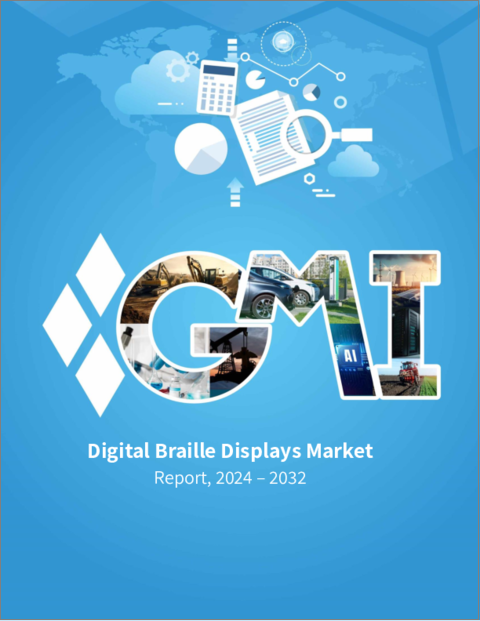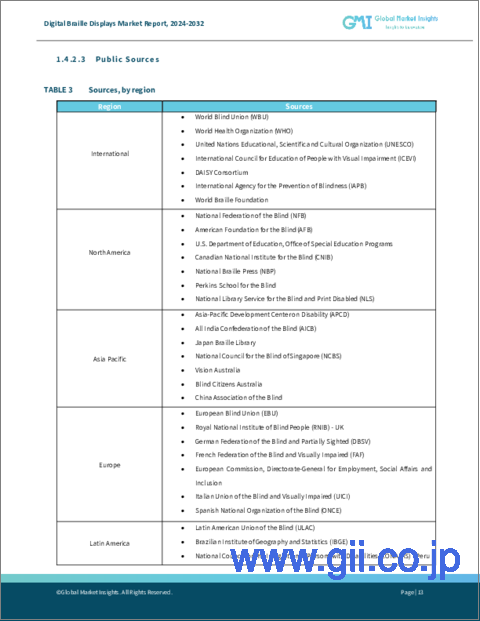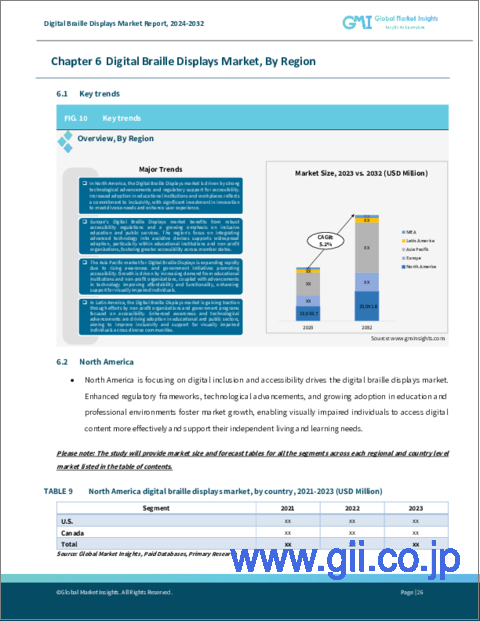|
|
市場調査レポート
商品コード
1568612
デジタル点字ディスプレイ市場、市場動向、成長促進要因、産業動向分析と予測、2024-2032年Digital Braille Displays Market, Opportunity, Growth Drivers, Industry Trend Analysis and Forecast, 2024-2032 |
||||||
カスタマイズ可能
|
|||||||
| デジタル点字ディスプレイ市場、市場動向、成長促進要因、産業動向分析と予測、2024-2032年 |
|
出版日: 2024年07月29日
発行: Global Market Insights Inc.
ページ情報: 英文 243 Pages
納期: 2~3営業日
|
全表示
- 概要
- 目次
デジタル点字ディスプレイの世界市場規模は、2024年から2032年にかけてCAGR 5%以上で成長し、パートナーシップやコラボレーションの急増がその原動力となります。
各団体は、技術的専門知識とアクセシビリティの目標を融合させ、効率的でユーザーフレンドリーなデバイスを作るために、これらのディスプレイを強化するために団結しています。このような共同努力により、触覚フィードバックや接続性を強化する機能が導入され、ユーザーのニーズに密接に合致しています。例えば、2022年12月、APHはDAISYコンソーシアムと協力し、新しいデジタル点字標準を開発しました。このパートナーシップは、触覚読書技術にまとまりのある強力な標準を制定することで、デジタル点字ディスプレイを向上させることを目的としています。
市場は、製品タイプ、ディスプレイタイプ、接続性、流通チャネル、技術、エンドユーザー、地域に分類されます。
製品タイプ別では、デジタル点字ディスプレイ産業におけるデスクトップ型点字ディスプレイ分野は、教育、コミュニケーション、デジタル読書における需要の高まりに起因して、2032年まで大きな成長率を遂げると思われます。各社は、強化された触覚フィードバックと優れた接続性を強調した新モデルを展開しています。これらの進歩は、日常の作業や専門的な取り組みにおけるデスクトップ型点字ディスプレイの有効性を強化することを目的としています。さらに、これらの機器には最先端技術が組み込まれており、デジタルコンテンツの明確で正確な点字表現を保証することで、ユーザーの情報へのアクセスを広げています。
技術別では、アクセシビリティとユーザビリティの向上に対する需要の高まりにより、電気活性ポリマー点字セル・セグメントによるデジタル点字ディスプレイ市場価値は、2024年から2032年にかけて上昇すると予測されています。電気活性ポリマー技術は、感度と精度の向上を誇る点字セルを製造しており、従来の点字に近いユーザー・インタラクションを可能にしています。さらに、継続的な進歩により、これらのポリマーベースのセルの耐久性、効率性、応答性が向上し、デジタル点字ディスプレイの信頼性と有効性が確固たるものとなっています。
地域的には、欧州のデジタル点字ディスプレイ産業規模は、2024年から2032年の間に力強い成長を遂げると予測されています。官民両セクターは、視覚障害者のアクセシビリティの向上を目指して、点字技術の進歩と普及のために資金と資源を増強しています。さらに、政府、NGO、技術革新者の相乗効果により、デジタル点字ディスプレイの画期的な進歩が促進され、大陸全域で、より手頃な価格で効率的、かつユーザー中心のディスプレイが実現されようとしています。
目次
第1章 調査手法と調査範囲
第2章 エグゼクティブサマリー
第3章 業界洞察
- エコシステム分析
- ベンダー・マトリックス
- 利益率分析
- テクノロジーとイノベーションの展望
- 特許分析
- 主要ニュースと取り組み
- 規制状況
- 影響要因
- 促進要因
- 視覚障害者の増加
- 点字ディスプレイ技術の進歩
- 政府の支援政策と資金援助
- アクセシビリティに対する認識と支持の高まり
- デジタル学習やテクノロジーとの統合
- 業界の潜在的リスク&課題
- 高い技術コスト
- 利用可能な点字コンテンツが限定的
- 促進要因
- 成長可能性分析
- ポーター分析
- PESTEL分析
第4章 競合情勢
- イントロダクション
- 企業シェア分析
- 競合のポジショニング・マトリックス
- 戦略展望マトリックス
第5章 市場推計・予測、製品タイプ、2021年~2032年
- 主要動向
- 携帯型点字ディスプレイ
- 卓上型点字ディスプレイ
- その他
第6章 市場推計・予測:ディスプレイタイプ別、2021年~2032年
- 主要動向
- 8ドット点字ディスプレイ
- 6ドット点字ディスプレイ
- その他
第7章 市場推計・予測:コネクティビティ別、2021年~2032年
- 主要動向
- USB
- Bluetooth
- Wi-Fi
- その他
第8章 市場推計・予測:エンドユーザー別、2021年~2032年
- 主要動向
- 視覚障害者
- 教育機関
- 企業および職場
- 政府機関
- 非営利団体
- その他
第9章 市場推計・予測:流通チャネル別、2021年~2032年
- 主要動向
- オンライン小売
- オフライン小売
- 直販
- 第三者流通業者
- その他
第10章 市場推計・予測:技術別、2021年~2032年
- 主要動向
- 圧電点字セル
- 電気活性ポリマー点字セル
- その他
第11章 市場推計・予測:地域別、2021年~2032年
- 主要動向
- 北米
- 米国
- カナダ
- 欧州
- 英国
- ドイツ
- フランス
- イタリア
- スペイン
- その他欧州
- アジア太平洋
- 中国
- インド
- 日本
- 韓国
- ニュージーランド
- その他アジア太平洋地域
- ラテンアメリカ
- ブラジル
- メキシコ
- その他ラテンアメリカ
- 中東・アフリカ
- UAE
- 南アフリカ
- サウジアラビア
- その他中東・アフリカ
第12章 企業プロファイル
- HumanWare
- Freedom Scientific
- Vispero
- Papenmeier
- Handy Tech Elektronik GmbH
- Eurobraille
- Harpo
- BAUM Retec AG
- Nippon Telesoft Co., Ltd.
- Amedia Corporation
- HIMS Inc.
- Perkins Solutions
- Orbit Research
- American Printing House for the Blind(APH)
- Dot Incorporation
- BRLTTY
- Tobii Dynavox
- VFO Group
- BrailleTech
- Appliance Science
- Braille Innovation
- GTT Braille Technology
- Brailletec
- Aroga Technologies
- Vispe
The Global Digital Braille Displays Market size will grow at over 5% CAGR from 2024 to 2032, fueled by a surge in partnerships and collaborations. Organizations are uniting to enhance these displays, merging technological expertise with accessibility goals to craft devices that are both efficient and user-friendly. These joint efforts are introducing features that bolster tactile feedback and connectivity, aligning closely with user needs. For example, in December 2022, APH collaborated with the DAISY Consortium to pioneer a new digital braille standard. This partnership aims to elevate digital braille displays by instituting a cohesive and potent standard for tactile reading technology.
The market is segregated into product type, display type, connectivity, distribution channel, technology, end user, and region.
In terms of product type, the desktop braille displays segment in the digital braille displays industry is set to experience a significant growth rate through 2032 attributed to rising demand across education, communication, and digital reading. Companies are rolling out new models, emphasizing enhanced tactile feedback and superior connectivity. These advancements aim to bolster the effectiveness of desktop braille displays for everyday tasks and professional endeavors. Moreover, these devices are incorporating cutting-edge technologies, ensuring a clear and accurate braille representation of digital content, thus broadening access of users to information.
By technology, the digital braille displays market value from the electroactive polymer braille cells segment is projected to rise from 2024 to 2032 driven by a heightened demand for improved accessibility and usability. Electroactive polymer technology is crafting braille cells that boast heightened sensitivity and accuracy, enabling user interactions that closely resemble traditional braille. Furthermore, ongoing advancements are amplifying the durability, efficiency, and responsiveness of these polymer-based cells, solidifying the reliability and effectiveness of digital braille displays.
Regionally, the Europe digital braille displays industry size is projected to witness robust growth between 2024 and 2032, largely due to backing from governments and NGOs. Both public and private sectors are ramping up funding and resources to advance and disseminate braille technologies, aiming to enhance accessibility for the visually impaired. Moreover, the synergy between governments, NGOs, and tech innovators is poised to drive breakthroughs in digital braille displays, making them more affordable, efficient, and user-centric across the continent.
Table of Contents
Chapter 1 Methodology and Scope
- 1.1 Market scope and definition
- 1.2 Base estimates and calculations
- 1.3 Forecast calculation
- 1.4 Data sources
- 1.4.1 Primary
- 1.4.2 Secondary
- 1.4.2.1 Paid sources
- 1.4.2.2 Public sources
Chapter 2 Executive Summary
- 2.1 Industry 360º synopsis, 2021 - 2032
Chapter 3 Industry Insights
- 3.1 Industry ecosystem analysis
- 3.2 Vendor matrix
- 3.3 Profit margin analysis
- 3.4 Technology and innovation landscape
- 3.5 Patent analysis
- 3.6 Key news and initiatives
- 3.7 Regulatory landscape
- 3.8 Impact forces
- 3.8.1 Growth drivers
- 3.8.1.1 Increasing prevalence of visual impairments
- 3.8.1.2 Advancements in braille display technology
- 3.8.1.3 Supportive government policies and funding
- 3.8.1.4 Growing awareness and advocacy for accessibility
- 3.8.1.5 Integration with digital learning and technology
- 3.8.2 Industry pitfalls and challenges
- 3.8.2.1 High costs of technology
- 3.8.2.2 Limited braille content availability
- 3.8.1 Growth drivers
- 3.9 Growth potential analysis
- 3.10 Porter's analysis
- 3.10.1 Supplier power
- 3.10.2 Buyer power
- 3.10.3 Threat of new entrants
- 3.10.4 Threat of substitutes
- 3.10.5 Industry rivalry
- 3.11 PESTEL analysis
Chapter 4 Competitive Landscape, 2023
- 4.1 Introduction
- 4.2 Company market share analysis
- 4.3 Competitive positioning matrix
- 4.4 Strategic outlook matrix
Chapter 5 Market Estimates and Forecast, Product Type, 2021 - 2032 (USD million)
- 5.1 Key trends
- 5.2 Portable braille displays
- 5.3 Desktop braille displays
- 5.4 Others
Chapter 6 Market Estimates and Forecast, By Display Type, 2021 - 2032 (USD million)
- 6.1 Key trends
- 6.2 8-dot braille displays
- 6.3 6-dot braille displays
- 6.4 Others
Chapter 7 Market Estimates and Forecast, By Connectivity, 2021 - 2032 (USD million)
- 7.1 Key trends
- 7.2 USB
- 7.3 Bluetooth
- 7.4 Wi-Fi
- 7.5 Others
Chapter 8 Market Estimates and Forecast, By End-User, 2021 - 2032 (USD million)
- 8.1 Key trends
- 8.2 Blind and visually impaired individuals
- 8.3 Educational institutions
- 8.4 Enterprises and workplaces
- 8.5 Government organizations
- 8.6 Non-profit organizations
- 8.7 Others
Chapter 9 Market Estimates and Forecast, By Distribution Channel, 2021 - 2032 (USD million)
- 9.1 Key trends
- 9.2 Online retail
- 9.3 Offline retail
- 9.4 Direct sales
- 9.5 Third-party distributors
- 9.6 Others
Chapter 10 Market Estimates and Forecast, By Technology, 2021 - 2032 (USD million)
- 10.1 Key trends
- 10.2 Piezoelectric braille cells
- 10.3 Electroactive polymer braille cells
- 10.4 Others
Chapter 11 Market Estimates and Forecast, By Region, 2021 - 2032 (USD million)
- 11.1 Key trends
- 11.2 North America
- 11.2.1 U.S.
- 11.2.2 Canada
- 11.3 Europe
- 11.3.1 UK
- 11.3.2 Germany
- 11.3.3 France
- 11.3.4 Italy
- 11.3.5 Spain
- 11.3.6 Rest of Europe
- 11.4 Asia Pacific
- 11.4.1 China
- 11.4.2 India
- 11.4.3 Japan
- 11.4.4 South Korea
- 11.4.5 ANZ
- 11.4.6 Rest of Asia Pacific
- 11.5 Latin America
- 11.5.1 Brazil
- 11.5.2 Mexico
- 11.5.3 Rest of Latin America
- 11.6 MEA
- 11.6.1 UAE
- 11.6.2 South Africa
- 11.6.3 Saudi Arabia
- 11.6.4 Rest of MEA
Chapter 12 Company Profiles
- 12.1 HumanWare
- 12.2 Freedom Scientific
- 12.3 Vispero
- 12.4 Papenmeier
- 12.5 Handy Tech Elektronik GmbH
- 12.6 Eurobraille
- 12.7 Harpo
- 12.8 BAUM Retec AG
- 12.9 Nippon Telesoft Co., Ltd.
- 12.10 Amedia Corporation
- 12.11 HIMS Inc.
- 12.12 Perkins Solutions
- 12.13 Orbit Research
- 12.14 American Printing House for the Blind (APH)
- 12.15 Dot Incorporation
- 12.16 BRLTTY
- 12.17 Tobii Dynavox
- 12.18 VFO Group
- 12.19 BrailleTech
- 12.20 Appliance Science
- 12.21 Braille Innovation
- 12.22 GTT Braille Technology
- 12.23 Brailletec
- 12.24 Aroga Technologies
- 12.24 Vispe





